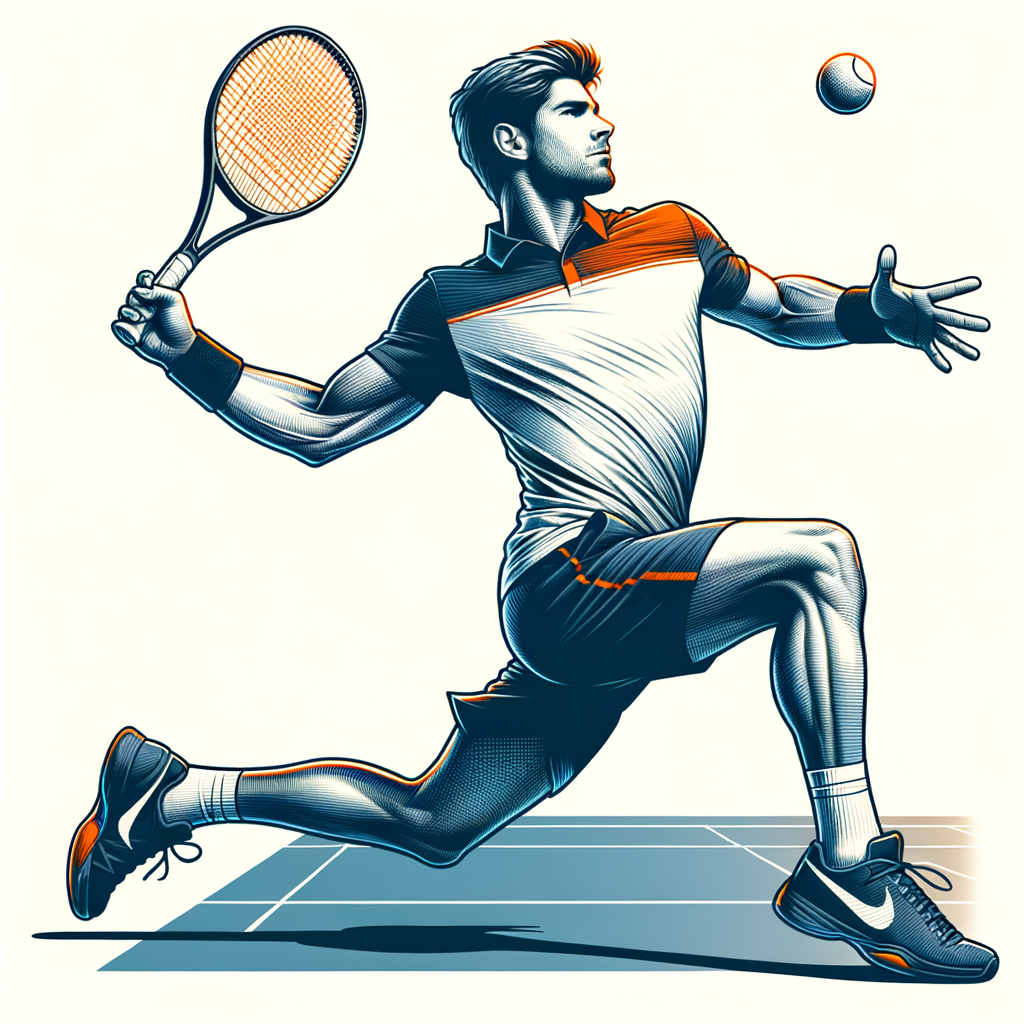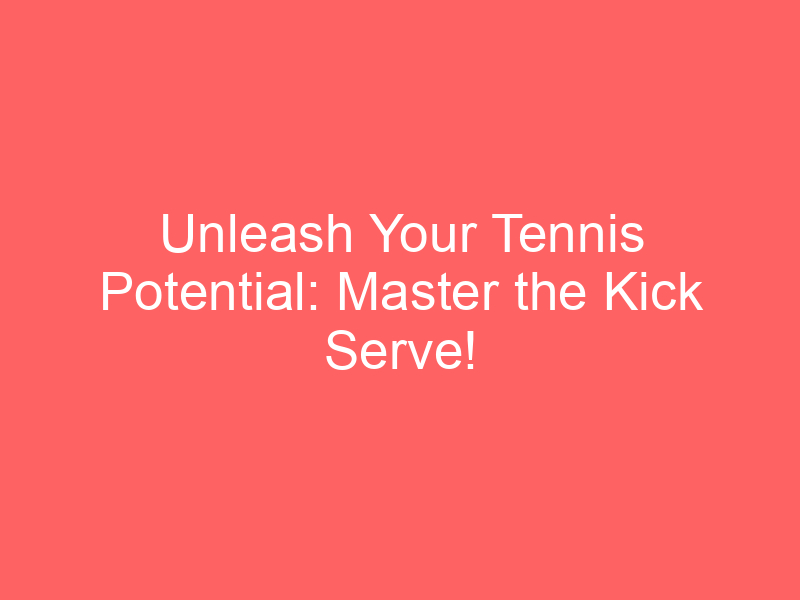
Introduction: Elevating Your Tennis Skills
Welcome to our comprehensive guide on improving your tennis skills. This blog post will focus primarily on the importance of mastering the tennis serve and how a powerful serve can significantly enhance your game. Let’s dive in!
- Understanding the Importance of Mastering Tennis Serve
- How a Powerful Serve Can Improve Your Tennis Game
Mastering the tennis serve is a crucial aspect of the game. It’s the first shot in a point and sets the tone for the rest of the rally. A well-executed serve can give you an edge over your opponent, allowing you to control the game from the outset. According to a study, professional players win about 70% of the points when they serve, highlighting the importance of a good serve.
A powerful serve is not just about strength; it’s about technique, timing, and precision. A strong serve can put your opponent on the back foot, forcing them to react rather than act. It can also open up the court for your next shot, making it easier for you to win points. For instance, Serena Williams, one of the greatest tennis players of all time, is known for her powerful serve, which has helped her win numerous matches.
Throughout this blog post, we will explore various serve techniques, from the basics to advanced strategies, and provide tips from the pros to help you elevate your tennis skills. So, whether you’re a beginner or an experienced player looking to improve, this guide is for you.
Tennis Serve Techniques: The Basics
Mastering the art of serving in tennis is crucial to your game. It’s the first shot in every point, and it sets the tone for the rest of the play. Let’s take a look at the basic types of tennis serves and how to execute them.
Types of Tennis Serves
There are three main types of serves in tennis. Each one has its own unique characteristics and uses in a match. Let’s break them down:
- Flat Serve
- Slice Serve
- Kick Serve
The flat serve is the most straightforward and powerful serve in tennis. It’s called a “flat” serve because the ball is hit with minimal spin, causing it to travel in a straight line. This serve is typically used for first serves, as it’s the fastest and most difficult for the opponent to return. However, it requires precision because it has less margin for error.
The slice serve involves hitting the ball with a side spin. This causes the ball to curve in the air, making it harder for the opponent to predict where it will land. The slice serve is often used as a second serve because it’s easier to control than the flat serve. It’s also a great strategic serve to use when you want to pull your opponent off the court.
The kick serve is the most complex serve in tennis. It involves hitting the ball with a lot of topspin, causing it to bounce high and to the side. This serve is difficult to master, but once you do, it can be a powerful weapon in your arsenal. The kick serve is often used as a second serve because its high bounce can throw off an opponent’s timing.
Now that we’ve covered the basics, it’s time to get out there and practice these serves. Remember, the key to a great serve is consistency. So, keep practicing until you can hit each serve with accuracy and power. In the next section, we’ll dive deeper into the kick serve and how to master it.
Tennis Kick Serve Tutorial: Mastering the Technique
Mastering the tennis kick serve can be a game-changer for any player. This serve, when executed correctly, can give you an edge over your opponent. Let’s delve into a step-by-step guide to perfecting this technique.
Step-by-Step Guide to a Perfect Kick Serve
Follow these steps to master the kick serve:
- Correct grip for a kick serve
The grip is the foundation of your serve. For a kick serve, the Continental grip is recommended. This grip involves holding the racket as if you were going to hammer a nail. It allows for the necessary wrist snap in the service motion. - Proper stance and positioning
Stand at a 45-degree angle to the baseline with your feet shoulder-width apart. Your weight should be on your back foot, ready to shift forward as you serve. - Importance of toss placement
Toss the ball slightly behind and to the left of your head (for right-handed players). This placement allows for the upward and outward swing path necessary for a kick serve. - Swing path and contact
Swing up at the ball with a brushing motion, making contact with the ball at the peak of your reach. The racket should make contact with the back and top of the ball to generate the desired spin. - Follow through and recovery
After contact, your racket should follow through across your body. Quickly get ready for the next shot, anticipating your opponent’s return.
Remember, practice makes perfect. Consistency and repetition are key to mastering the kick serve. Keep practicing these steps, and you’ll soon see improvement in your game.
Common Mistakes to Avoid
As you strive to master the tennis kick serve, there are a few common mistakes that can hinder your progress. By identifying and avoiding these pitfalls, you can greatly improve your technique and overall performance.
- Incorrect Grip
- Poor Toss Placement
- Insufficient Body Rotation
One of the most common mistakes players make is holding the racket incorrectly. An incorrect grip can lead to a weak serve and even injuries over time. The continental grip, often referred to as the “hammer grip,” is the most recommended for a kick serve. It allows for a wide range of motion and the right amount of spin.
Another common mistake is poor toss placement. The toss should be slightly to your left (for right-handed players) and slightly behind you. This allows for the necessary upward and forward swing to generate the topspin needed for a kick serve. A poorly placed toss can result in a weak serve or even a fault.
Lastly, insufficient body rotation can greatly affect the power and accuracy of your serve. Your body should rotate from a coiled position to a fully extended one during the serve. This rotation generates the power needed for a strong serve. Not rotating enough can lead to a lack of power and control.
By avoiding these common mistakes, you can improve your kick serve technique and become a more formidable player on the court. Remember, practice makes perfect. So, keep practicing and refining your technique until you master the kick serve.
Advanced Tennis Serve Techniques: Taking Your Game to the Next Level
As you continue to grow in your tennis journey, mastering advanced serve techniques becomes crucial. These techniques can give you a competitive edge and take your game to the next level. One such technique that requires attention is the kick serve. Let’s delve into how you can improve your kick serve.
Improving Your Kick Serve
The kick serve is a powerful tool in any tennis player’s arsenal. It involves a high bounce, making it difficult for your opponent to return. Improving your kick serve involves three key aspects: adding more spin, increasing serve speed, and improving accuracy. Let’s explore each of these in detail.
- Adding more spin: The spin is what gives the kick serve its unique bounce. To add more spin, focus on brushing up the back of the ball during your serve. This upward motion generates the topspin needed for a successful kick serve. Practice this motion repeatedly to increase your spin over time.
- Increasing serve speed: A faster serve can catch your opponent off guard and give you an advantage. To increase your serve speed, work on your arm and wrist strength. Exercises like wrist curls and tricep dips can help. Additionally, ensure your serve motion is fluid and fast, not jerky or slow.
- Improving accuracy: An accurate serve can put your opponent in a difficult position right from the start. To improve your serve accuracy, practice targeting different areas of the service box. Use cones or markers to set targets and aim to hit them consistently. Remember, practice makes perfect.
Mastering these advanced serve techniques can significantly improve your tennis game. It may take time and practice, but the results will be worth the effort. So, get out there and start practicing your kick serve!
Tennis Kick Serve Tips: Insights from the Pros
When it comes to mastering the tennis kick serve, there’s no better place to turn than the professionals. They’ve honed their skills over countless hours of practice and competition, and their insights can provide invaluable guidance for players of all levels. Let’s delve into some of their top tips for perfecting this crucial aspect of the game.
Professional Tennis Serving Tips
Here are some key tips from professional tennis players that can help you improve your kick serve:
- Practicing Consistency
- Developing a Unique Serving Style
- Understanding Opponent’s Weaknesses
Consistency is the cornerstone of a strong tennis serve. The pros recommend practicing your serve daily, focusing on maintaining a steady rhythm and hitting the ball at the same point every time. This will help you develop a reliable, effective serve that can withstand the pressures of a competitive match.
Every tennis player is unique, and your serve should reflect that. While it’s important to learn the fundamentals, the pros encourage players to experiment and find a serving style that feels natural and comfortable. This could involve adjusting your grip, changing your stance, or even incorporating a signature move. The key is to make your serve your own.
One of the most effective ways to gain an edge in tennis is by understanding your opponent’s weaknesses. If you notice that your opponent struggles to return high-bouncing serves, for example, you might decide to use your kick serve more frequently. By adapting your strategy to exploit your opponent’s weaknesses, you can increase your chances of winning the match.
In conclusion, mastering the tennis kick serve requires consistent practice, a unique serving style, and a keen understanding of your opponent’s weaknesses. By incorporating these professional tips into your training regimen, you can elevate your game and become a more formidable competitor on the court.
Conclusion: Tennis Game Mastery
As we wrap up our discussion on tennis serves, let’s take a moment to revisit the key points we’ve covered. Remember, the journey to tennis game mastery is a continuous process of learning and refining your skills.
- Recap of the importance of a powerful serve:
- How mastering the kick serve can elevate your game:
Your serve is the first shot in a point and can set the tone for the entire game. A powerful serve can give you an edge over your opponent, making it harder for them to return the ball. It’s not just about power, though. Accuracy and consistency are equally important. As we’ve learned, a well-placed serve can force your opponent into a defensive position, giving you a chance to control the game.
The kick serve is a powerful tool in any tennis player’s arsenal. When executed correctly, it can be a game-changer. The tricky bounce it creates can throw off your opponent’s timing, giving you a significant advantage. Mastering the kick serve requires practice and patience, but the payoff is well worth it. As we’ve seen in our tutorial, the key is in the toss and the swing. Keep practicing, and you’ll soon see improvement in your game.
Remember, every tennis player, even the pros, started from the basics. It’s about constant learning and improvement. Keep practicing, stay patient, and never stop learning. With time and dedication, you’ll see your game reach new heights. Here’s to your journey towards tennis game mastery!






